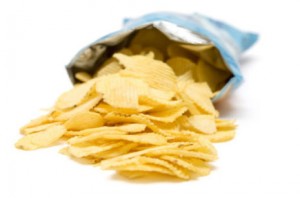You may have heard in the news recently that PepsiCo created a salt for its Lay’s potato chips (and other Frito products) that will reduce salt content. At first glance, it seems like a gimmick. You might even think they are trying to make people think that their snack products are healthier. But, there’s actually more to it than that.
I talked with the Director of Public Relations and Marketing, Aurora Gonzalez, about the new salt and got some interesting health-related information.
Frito-Lay cares about making a good product. They were the first company to remove trans fats in favor of sunflower oil. They are thinking about sodium in terms of “if there is something we can do, we should do it.” They know people are concerned about salt intake. They also know that people like seasonings, and products with seasonings tend to have higher salt. So they’ve been looking into sodium and playing with the structure to reduce the total sodium content. They’re doing it because it’s the right thing to do. Frito-Lay realizes consumers struggle with salt intake. Basically, they are trying to make a small dent, while keeping up the integrity of the quality ingredients.
They already have a line with 50 percent less sodium – the “lightly salted” line of Lay’s, Ruffles, Fritos, and the soon-to-come Rold Gold pretzels. These are just made with less salt. Nothing new.
As a dietitian, this is what I would recommend to people who are actively trying to reduce salt, but still want to enjoy chips or pretzels in moderation: It’s up to you to make sure you get your fruits and veggies. And, if you like chips, it’s also up to you to eat and enjoy a small portion. I will often tell chip eaters to avoid eating them alone. Make a sandwich with whole grain bread, lean protein, and veggies. Add a side of crunchy veggies, such as sugar snap peas, and then a handful of chips.
Savor the bites. If you’re the kind who eats chips out of the bag in front of the TV, it’s important to acknowledge that it’s not the chips, it’s how you are choosing to eat them.
The other thing to keep in mind is that the original version of the potato chip actually doesn’t have much salt. If you turn the bag around and read it, the salt is not that high (compare it to a cup of tomato soup, which can have 5 to 10 times the salt). Read the ingredients. Not a lot there. The best thing you can do is control the portion.
As far as the designer salt goes, don’t expect it to make a serious dent in your sodium intake. Instead, cut back on eating out at restaurants. Or, when you go, ask for your meals to be prepared without salt. There are many examples of meals that have 1-2 days worth of salt in one serving. No amount of “low salt” product can reverse those abnormally high numbers.
Next time you go out, start with a garden salad and share an entree of whatever you want with someone else. Eat slowly and mindfully and stop when you feel full, regardless if there is food left. Skip the alcohol, bread, appetizers, and desserts, and even the “worst” meal won’t be a bad. Make that small change and you should see some great results.
